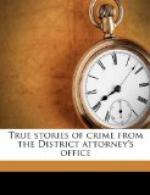The District Attorney’s office now took up a thorough investigation of the case, with the result that on a second prosecution Mrs. Parker was confronted with a mass of evidence which it was impossible for her to refute. A boy named Wallace Sweeney, sentenced to the Elmira Reformatory, was found to have been an active accomplice of the Parkers for several years, and he was accordingly brought down to New York, where he gave a complete history of his relations with them. His story proved beyond any doubt that Mrs. Parker was the forger of the checks in the possession of the District Attorney, and of many others beside, some of them for very large amounts. The evidence of Sweeney was of itself quite sufficient to warrant a conviction. To make assurance doubly sure, however, the District Attorney upon the second trial moved a new indictment, setting forth as the forgery a check signed “E. Bierstadt,” so that when Parker took the stand, as he had done in the former trial and testified that he was the forger, he found himself unable to write this new signature, and hence his testimony went for nothing.
But even the testimony of Sweeney was that of an accomplice, requiring corroboration, while that of Peabody remained the evidence of “a mere policeman,” eager to convict the defendant and “add another scalp to his official belt.” With an extraordinary accumulation of evidence the case hinged on the veracity of these two men, to which was opposed the denial of the defendant and her husband. It is an interesting fact that in the final analysis of the case the jury were compelled to determine the issue by evidence entirely documentary in character. It is also an illustration of what tiny facts stamp whole masses of testimony as true or false.
On her examination Mrs. Parker had sworn among other things: (1) That she had no knowledge of the envelope, the back of which had been used by Parker for the purpose of directing Rogers, Peet & Co. to deliver the clothes and money to his messenger—and, of course, that the words “Mr. Geo. B. Lang” were not in her handwriting. This was one of the envelopes claimed by the prosecution to have been originally addressed in pencil and sent to themselves by the Parkers through the mail for this precise purpose. (2) That she had never seen the “Kauser practice sheets,” and that the words “Alice Kauser,” repeated hundreds of times thereon, were not in her handwriting. For some reason unknown to the District Attorney, however, she admitted having written the words “I am upstairs in the bath-room” upon a similar sheet, but claimed that at the time this was done the reverse of the paper was entirely blank.




